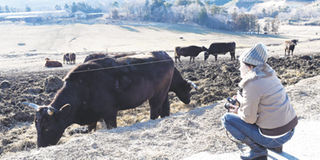Fukushima becomes hotspot for ‘dark tourism’

A participant of “dark tourism” looks at cows which survive eating contaminated grass at a ranch in Namie, Fukushima Prefecture after the accident of Fukushima nuclear plant on February 11. As the fifth anniversary of the disaster approaches, a growing number of visitors are joining Fukushima-related tours. PHOTO | AFP
What you need to know:
Five years after the nuclear disaster emptied much of Japan’s northeastern coast, tourism is giving locals of the abandoned town a chance to exorcise the horrors of the past.
Namie. Shinichi Niitsuma enthusiastically shows visitors the attractions of the small town of Namie: its tsunami-hit coastline, abandoned houses and hills overlooking the radiation-infested reactors of the disabled Fukushima nuclear plant.
Five years after the nuclear disaster emptied much of Japan’s northeastern coast, tourism is giving locals of the abandoned town a chance to exorcise the horrors of the past.
Like the Nazi concentration camps in Poland or Ground Zero in New York, the areas devastated by the Fukushima disaster have now become hotspots for “dark tourism” and draw annually more than 2,000 visitors keen to see the aftermath of the worst nuclear accident in a quarter century.
“There is no place like Fukushima -- except maybe Chernobyl -- to see how terrible a nuclear accident is,” Niitsuma said, referring to the 1986 accident in Ukraine.
“I want visitors to see this ghost town, which is not just a mere legacy but clear and present despair,” he added, as he drove visitors down the main street of Namie, which lies just eight kilometres (five miles) from the stricken nuclear plant. On March 11, 2011, a magnitude 9.0 undersea earthquake off Japan’s northeastern coast sparked a massive tsunami that swept ashore leaving 19,000 people dead or missing.
Namie’s residents were evacuated after the tsunami sent the nuclear plant into meltdown and none has yet been allowed to move back over radiation concerns. Niitsuma, 70, is one of 10 local volunteer guides organising tours to sights in Namie and other Fukushima communities, including tightly regulated restricted areas.
The volunteers take visitors through the shells of buildings left untouched as extremely high levels of radiation hamper demolition work. The guides use monitoring dosimeters to carefully avoid radiation “hotspots”.
A tsunami-hit elementary school is another stop on the morbid tour. Clocks on the classroom walls are stopped at 3:38 pm, the exact moment killer waves swept ashore. (AFP)




